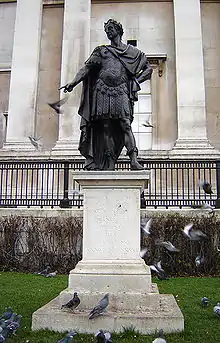Laurence Vander Meulen
Laurence Vander Meulen, born in Mechelen in 1643 and died in his hometown in 1719 was a Flemish sculptor.

Laurence Vander Meulen | |
|---|---|
| Born | 1643 |
| Died | 1719 Mechelen |
| Known for | Sculpture |
Notable work | Statue of King James II, Trafalgar Square |
He is most famous for having worked on the statue of King James II in Trafalgar Square along with the sculptor Peter van Dievoet from Brussels for the workshop of Grinling Gibbons.[1]
Biography
Laurence Vander Meulen began his training in his hometown, which had a rich school of sculpture, and after beginning the study of painting, he was attracted by this art and trained at twenty, that is to say late enough to an apprentice, in the workshop of the renowned Malinois sculptor Pierre Vander Stock. He did not stay there long, and before reaching mastery, which he will accomplish after his return to Mechelen, he went to England where, following the London fire and his rebuilding, there was a strong demand in the crafts.
He went to join the important colony of Flemish artists, painters, sculptors, tapestry makers, etc. who was active there.
This is how it is found in London alongside other compatriots,[2] like Arnold Quellin, the son of Artus Quellinus, John Nost, also Malinois, Antoon Verhuke and Peter Van Dievoet, in the workshop of Grinling Gibbons a Virtuoso sculptor in the fine carving of floral motifs.
Considering no doubt that his training was sufficient and he now equaled his master he returned in 1687 in his hometown, which allowed him to avoid the troubles of the Revolution of 1688.
In order to be able to settle on his own country, he completed the formalities to achieve mastery and then married Cornelia-Thérèse de Croes, sister-in-law of the sculptor Jean-Luc Faydherbe, son of the great sculptor Lucas Faydherbe, he was entering the most influential art scene in the Netherlands.
He thus began a fruitful career as an ornamental sculptor, decorating many churches and mansions with his ornaments composed of garlands of flowers, scissors and the fine carving of a goldsmith. Beside this, religious statues, virgins, and some busts are also mentioned.
Despite the abundance of his work it has become very rare and scattered, which makes the study difficult.
Bibliography
- Emmanuel Neefs, Histoire de la peinture et de la sculpture à Malines, Gand, imprimerie E. Vanderhaegen, 1876, 2 vol.
- Adolphe Siret, Dictionnaire historique des peintres de toutes les écoles: depuis les temps les plus reculés jusqu'à nos jours, Librairie Encyclopédique de Périchon, 1848.
- Messager des sciences historiques, 1836.
Notes
- Horace Walpole, Anecdotes of painting in England: with some account of the principal artists; and incidental notes on other arts; collected by the late Mr. George Vertue; and now digested and published from his original MSS. by Mr. Horace Walpole, London, 1765, vol. III, p. 91 : « Gibbons had several disciples and workmen; Selden I have mentioned; Watson assisted chiefly at Chatsworth, where the boys and many of the ornaments in the chapel were executed by him. Dievot of Brussels, and Laurens of Mechlin were principal journeymen — Vertue says they modelled and cast the statue I have mentioned in the privy-garden ». According to David Green, in Grinling Gibbons, his work as carver and statuary (London, 1964), one Smooke sayd to Vertue that this statue "was modelled and made by Laurence and Devoot (sic)"; George Vertue, Note Books, ed. Walpole Society, Oxford, 1930–47, vol. I, p.82 : "Lawrence. Dyvoet. statuarys", and ibidem IV, 50 : "Laurens a statuary of Mechlin... Dievot a statuary of Brussels both these artists were in England and assisted Mr. Gibbons in statuary works in K. Charles 2d. and K. James 2d. time, they left England in the troubles of the Revolution and retird to their own country".
- "Gibbons, Grinling", in : Oxford Dictionary of National Biography, vol. 22, pp. 29–30 : "The attribution of these works is complicated by the presence of the highly trained Flemish sculptors whom Gibbons had gathered into his workshop by the end of the 1670s. These included Arnold Quellin (the nephew of Artus Quellinus I), John Nost, and Anthony Verhuke, joined in the next decade by, among others, Laurens Vander Meulen and Pierre Van Dievoet. Their experience and skill as makers of statues may have exceeded his own".
Sources
Content in this edit is translated from the existing French Wikipedia article at fr:Laurent Vander Meulen; see its history for attribution.